#Nation symbol identification
Text
Coral today is an icon of environmental crisis, its disappearance from the world’s oceans an emblem for the richness of forms and habitats either lost to us or at risk. Yet, as Michelle Currie Navakas shows in her eloquent book, Coral Lives: Literature, Labor, and the Making of America, our accounts today of coral as beauty, loss, and precarious future depend on an inherited language from the nineteenth century. [...] Navakas traces how coral became the material with which writers, poets, and artists debated community, labor, and polity in the United States.
The coral reef produced a compelling teleological vision of the nation: just as the minute coral “insect,” working invisibly under the waves, built immense structures that accumulated through efforts of countless others, living and dead, so the nation’s developing form depended on the countless workers whose individuality was almost impossible to detect. This identification of coral with human communities, Navakas shows, was not only revisited but also revised and challenged throughout the century. Coral had a global biography, a history as currency and ornament that linked it to the violence of slavery. It was also already a talisman - readymade for a modern symbol [...]. Not least, for nineteenth-century readers in the United States, it was also an artifact of knowledge and discovery, with coral fans and branches brought back from the Pacific and Indian Oceans to sit in American parlors and museums. [...]
---
[W]ith material culture analysis, [...] [there are] three common early American coral artifacts, familiar objects that made coral as a substance much more familiar to the nineteenth century than today: red coral beads for jewelry, the coral teething toy, and the natural history specimen. This chapter is a visual tour de force, bringing together a fascinating range of representations of coral in nineteenth-century painting and sculptures.
With the material presence of coral firmly in place, Navakas returns us to its place in texts as metaphor for labor, with close readings of poetry and ephemeral literature up to the Civil War era. [...] [Navakas] includes an intriguing examination of the posthumous reputation of the eighteenth-century French naturalist Jean-André Peyssonnel who first claimed that coral should be classed as an animal (or “insect”), not plant. Navakas then [...] considers white reformers, both male and female, and Black authors and activists, including James McCune Smith and Frances Ellen Watkins Harper, and a singular Black charitable association in Cleveland, Ohio, at the end of the century, called the Coral Builders’ Society. [...]
---
Most strikingly, her attention to layered knowledge allows her to examine the subversions of coral imagery that arose [...]. Obviously, the mid-nineteenth-century poems that lauded coral as a metaphor for laboring men who raised solid structures for a collective future also sought to naturalize a system that kept some kinds of labor and some kinds of people firmly pressed beneath the surface. Coral’s biography, she notes, was “inseparable from colonial violence at almost every turn” (p. 7). Yet coral was also part of the material history of the Black Atlantic: red coral beads were currency [...].
Thus, a children’s Christmas story, “The Story of a Coral Bracelet” (1861), written by a West Indian writer, Sophy Moody, described the coral trade in the structure of a slave narrative. [...] In addition, coral’s protean shapes and ambiguity - rock, plant, or animal? - gave Americans a model for the difficulty of defining essential qualities from surface appearance, a message that troubled biological essentialists but attracted abolitionists. Navakas thus repeatedly brings into view the racialized and gendered meanings of coral [...].
---
Some readers from the blue humanities will want more attention, for example, to [...] different oceans [...]: Navakas’s gaze is clearly eastward to the Atlantic and Mediterranean and (to a degree) to the Caribbean. Many of her sources keep her to the northern and southeastern United States and its vision of America, even though much of the natural historical explorations, not to mention the missionary interest in coral islands, turns decidedly to the Pacific. [...] First, under my hat as a historian of science, I note [...] [that] [q]uestions about the structure of coral islands among naturalists for the rest of the century pitted supporters of Darwinian evolutionary theory against his opponents [...]. These disputes surely sustained the liveliness of coral - its teleology and its ambiguities - in popular American literature. [...]
My second desire, from the standpoint of Victorian studies, is for a more specific account of religious traditions and coral. While Navakas identifies many writers of coral poetry and fables, both British and American, as “evangelical,” she avoids detailed analysis of the theological context that would be relevant, such as the millennial fascination with chaos and reconstruction and the intense Anglo-American missionary interest in the Pacific. [...] [However] reasons for this move are quickly apparent. First, her focus on coral as an icon that enabled explicit discussion of labor and community means that she takes the more familiar arguments connecting natural history and Christianity in this period as a given. [...] Coral, she argues, is most significant as an object of/in translation, mediating across the Black Atlantic and between many particular cultures. These critical strategies are easy to understand and accept, and yet the word - the script, in her terms - that I kept waiting for her to take up was “monuments”: a favorite nineteenth-century description of coral.
Navakas does often refer to the awareness of coral “temporalities” - how coral served as metaphor for the bridges between past, present, and future. Yet the way that a coral reef was understood as a literal graveyard, in an age that made death practices and new forms of cemeteries so vital a part of social and civic bonds, seems to deserve a place in this study. These are a greedy reader’s questions, wanting more. As Navakas notes in a thoughtful coda, the method of the environmental humanities is to understand our present circumstances as framed by legacies from the past, legacies that are never smooth but point us to friction and complexity.
---
All text above by: Katharine Anderson. "Review of Navakas, Michele Currie, Coral Lives: Literature, Labor, and the Making of America." H-Environment, H-Net Reviews. December 2023. Published at: [networks.h-net.org/group/reviews/20017692/anderson-navakas-coral-lives-literature-labor-and-making-america] [Bold emphasis and some paragraph breaks/contractions added by me. Presented here for commentary, teaching, criticism.]
#ecologies#tidalectics#multispecies#geographic imaginaries#ecology#archipelagic thinking#interspecies
63 notes
·
View notes
Text
reading more about atomic gardening and this is so much fun. to read about that is. it also seems fun to do, but. you know. anyway:
"The story of these citizen-pioneers of mutagenesis (the technical term for creating genetic change through the application of chemical, physical, and biological agents) is full of fantastic details, from Muriel Howorth’s propagandising ballet-mime, Isotopia, which involved a cast of Knowledge, Electron, Proton, Neutron, Rat, and Cow, as well as a working geiger counter, to Tennessee-based atomic entrepreneur C.J. Speas irradiating trays of seedlings into his backyard bunker.

IMAGE: C.J. Speas giving a tour of his radioactive bunker to high school students, photo by Grey Villet for Life, via Pruned.
Perhaps the most bizarre detail in the interview, however, is the news that these gamma gardens are still in operation, relatively unchanged in design since the 50s, in the grounds of national laboratories today. Their circular form, which, as Johnson notes, bears more than a passing resemblance to the atomic danger symbol, “was simply based upon the need to arrange the plants in concentric circles around the radiation source which stood like a totem in the center of the field.”
It was basically a slug of radioactive material within a pole; when workers needed to enter the field it was lowered below ground into a lead lined chamber. There were a series of fences and alarms to keep people from entering the field when the source was above ground. The amount of radiation received by the plants naturally varied according to how close they were to the pole.
So usually a single variety would be arranged as a ‘wedge’ leading away from the pole, so that the effects of a range of radiation levels could be evaluated. Most of the plants close to the pole simply died. A little further away, they would be so genetically altered that they were riddled with tumors and other growth abnormalities. It was generally the rows where the plants ‘looked’ normal, but still had genetic alterations, that were of the most interest, that were ‘just right��� as far as mutation breeding was concerned!
Over at GOOD, Peter Smith recently described a similar layout at the still-active Institute of Radiation Breeding, in Hitachiohmiya, Japan, which has “has a 88.8 Terabecquerel Cobalt-60 source, ringed by a 3,608-foot radius Gamma field (the world’s largest), and a 28-foot high shield dike around the perimeter.”

IMAGE: A gamma garden at Brookhaven National Labs, New York, c. 1958; image provided by Paige Johnson, via Pruned.

IMAGE: Aerial view of the Institute of Radiation Breeding, Hitachiohmiya, Japan.
As it turns out, far from being a fantastic fossil from the future that never was, along with jetpacks and flying cars, atomic gardening is alive and well today. According to a 2007 New York Times story, which quotes Dr. Pierre Lagoda, head of plant breeding and genetics at the International Atomic Energy Agency, radiation breeding is actually experiencing a renaissance, due to the introduction of “new methods that speed up the identification of mutants.”

IMAGE: Mutant crop varieties mapped by The New York Times.
What’s more, the Times adds, nearly 2,000 gamma radiation-induced mutant crop varieties have been registered around the world, including Calrose 76, a dwarf varietal that accounts for about half the rice grown in California, and the popular Star Ruby and Rio Red grapefruits, whose deep colour is a mutation produced through radiation breeding in the 1970s. Similarly, Johnson tells Pruned that “most of the global production of mint oil,” with an annual market value estimated at $930 million, is extracted from the “wilt-resistant ‘Todd’s Mitcham’ cultivar, a product of thermal neutron irradiation.” She adds that “the exact nature of the genetic changes that cause it to be wilt-resistant remain unknown.”

IMAGE: “Pierre Lagoda, the head of plant breeding and genetics at the International Atomic Energy Agency, showing mutated plants at a greenhouse in Austria,” photo by Herwig Prammer for The New York Times."
34 notes
·
View notes
Text

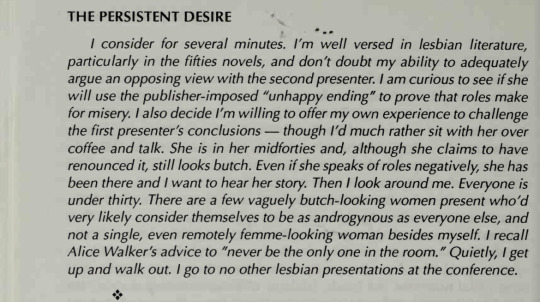
"The main justification for invalidating butch-femme is that its an imitation of heterosexual roles and, therefore, not a genuine lesbian model. One is tempted to react by saying "So what?" but the charge encompasses more than betrayal of an assumed fixed and "true" lesbian culture. Implicit in the accusation is the denial of cultural agency to lesbians, of the ability to shape and reshape symbols into new meanings of identification. Plagiarism, as the adage goes, is basic to all culture.
In the real of cultural identity, that some of the markers of a minority culture's boundaries originate in an oppressing culture is neither unusual nor particularly significant. For instance, in the United States certain kind of bead- and ribbon work are immediately recogniziable as specific to Native American cultures, wherein they serve artistic and ceremonial functions. Yet beads, trinkets, ribbons, and even certain "indian" blanket patterns were brought by Europeans, who traded them as cheap goods for land. No one argues that Indians out to give up beadwork or blanket weaving, thus ridding themselves of the oppressors symbols, because those things took on a radically different cultural meaning in the hands of Native Americans. Or consider Yiddish, one of the jewish languages. Although Yiddish is written in Hebrew characters and has its own idioms and nuances, its vocabulary is predominantly German. Those who speak German can understand Yiddish. Genocidal Germanic anti-Semitism dates back to at least the eleventh century. Yet East European Jews spoke "the oppressors language," developing in it a distinctive literary and theatrical tradition. Why is it so inconceivable that lesbians could take elements of heterosexual sex roles and remake them?
*
It is June 1987, and I am sitting in a workshop on "Lesbians and Gender Roles" at the annual National Women's Studies Conference. It is one of surprisingly few workshops on lesbian issues, particularly since, at a plenary session two mornings later, two thirds of the conference attendees will stand up as lesbians. Meanwhile, in this workshop the first speaker is spending half an hour on what she calls "Feminism 101," a description of heterosexual sex roles. Her point in doing this, she says, is to remind us of the origin of roles, "which are called butch and femme when lesbians engage in them." She tells us the purpose of her talk will be to prove, from her own experience, that "these roles are not fulfilling" for lesbians. She tells us that the second speaker will use lesbian novels from the 1950s to demonstrate the same thesis. And, indeed, the second speaker has a small stack of 1950s "pulp paperbacks" with her, many of them the titles that, when I discovered them in the mind-1970s, resonated for me in a way that the feminist books published by Daughters and Diana Press did not.
I consider for several minutes. I'm well versed in lesbian literature, particularly in the fifties novels, and don't doubt my ability to adequately argue an opposing view with the second presenter. I am curious to see if she will use the publisher-imposed "unhappy ending" to prove that roles make for misery. I also decide I'm willing to offer my own experience to challenge the first presenters conclusions- though I'd much rather sit with her over coffee and talk. She is in her midforties and, although she claims to have renounced it, still looks butch. Even if she speaks of roles negatively, she has been there and I want to hear her story. Then I look around me. Everyone is under thirty. There are a few vaguely butch-looking women present who'd very likely consider themselves to be as androgynous as everyone else, and not a single, even remotely femme-looking women besides myself. I recall Alice Walker's advice to "never be the only one in the room." Quietly, I get up and walk out. I go to no other lesbian presentations at the conference."
“Recollecting History, Renaming Lives: Femme Stigma and the feminist seventies and eighties" by Lyndall MacCowan, The Persistent Desire, (edited by Joan Nestle) (1992)
#the persistent desire#Lyndall MacCowan#Joan nestle#lesbian#lesbianism#butch and femme#butchfemme#butch and femme history#butch lesbian#femme lesbian#butch history#femme history#lesbian history#lesbian culture#lesbian feminism#lesbian feminist history#lgbt history#queer history
102 notes
·
View notes
Text
otherspirit!
otherspirit-
PT ID: bold title text reading ‘otherspirit’. End PT ID.
a term under the otherkin umbrella where one physically identifies as one species/thing (which can be human, but does not have to be), but spiritually/in their soul/heart, identify as a different one. one physically identifies with a certain species or thing, but they view their spirit/soul/heart as being something different. it can be described in this way- one envisions their body as species/thing A, but their spirit/soul/heart as species/thing B. Your soul is the manifestation of one thing, while your physical body is a manifestation of another.
alternatively, otherspirit can describe when one physically and spiritually identifies as the same thing, but they feel a much greater connection to the spiritual/soul/heart aspect of their identity or place greater emphasis on it.
as an example- i fully physically identify as human. i am comfortable with my human identity on a physical level, but i envision my spirit as that of a raven’s spirit. i am a ravenspirited human.
this term may also be called othersoul!
terminology/examples-
PT ID: bold title text reading “terminology/examples”. End PT ID.
otherspirit/otherspirited/othersoul/othersouled: “i am otherspirit/otherspirited/othersoul/othersouled”
spirittype/soultype: “my spirittype/soultype is (x)”
(x)spirited/(x)souled: “i am ravenspirited/i am ravensouled”
disclaimer:
PT ID: bold title text reading “disclaimer”. End PT ID.
This term is NOT related to the term “spirit animal”. “Spirit animal” is a culturally appropriative term that misunderstands, makes light of, tokenizes, and often fetishizes the cultures of Indigenous people around the world, but especially Native Americans and First Nations people (you can read more about this here, here, and here ). This term is not at all about appropriating important concepts from Indigenous cultures, and is just in reference to personal identity. It is about personal identification of one’s spirit/soul/heart as something, not taking others’ cultures and using them for fun. As such, please do NOT use the term “spirit animal” to describe your identification with this term. Instead of saying “(x) is my spirit animal”, say “(x) is my spirittype”. If I see anybody using this term to disrespect Native people and cultures, I will not hesitate to correct you, and I ask that if anyone else sees that, that they correct them as well.

[Image ID: A flag with seven equally-sized horizontal stripes. From top to bottom, the colors are purple, blue, bright cyan, white, pastel golden, red-pink, and purple. In the center of the flag, there is a black symbol. It is an outer black ring with a black square ring inside it and a black 8-pointed star inside that. End ID.]

[Image ID: A black symbol. It is an outer black ring with a black square ring inside it and a black 8-pointed star inside that. End ID.]
tagging @kiruliom @neopronouns @epikulupu @revenant-coining @gender-mailman @dreamythism @delusielle @crying-roses @lovesse @blood-moon-night-coining @lovesickangelguts @starznvoidz @adoraboy
#🌌a star is born ; coining🌌#otherkin#liom coining#new liom term#liom community#otherspirit#otherspirited#othersoul#othersouled
140 notes
·
View notes
Text
A Thing Of Vikings Chapter 148: Assumptions Of Power

Chapter 148: Assumptions Of Power
It should be noted that the process of forming a national identity is a significant one in itself. Citizenship is only part of the answer, as most people will still identify with their immediate regional, ethnic, or religious group, allowing for social fault lines to form. Generally speaking, a central “pole” is needed to act as a unifying force of identification in any large-scale nation-state. This can be a national epic, a written constitution, a venerated royal dynasty, an ideology, a larger ethnicity, or a religious institution, but to help weld together more multitudinous groups, some unifying symbol of identification is needed to be able to create the social institutions that allow for members of the nation to identify as members of the nation, as opposed to seeing themselves as part of the nation only through their identity as members of a social group which is a constituent part of that nation.
This might seem like splitting semantics, but it is an important distinction. If a feudal count declares war on his neighboring count in the hope of taking some of the man’s territory, despite them being part of the same kingdom, which perspective is more useful for halting hostilities? That their levies owe them fealty and thus must follow their orders? Or that their levies are being ordered to attack and kill their fellow subjects of the kingdom? The latter is clearly the more effective means by which to bond the two disparate groups together under a single unifying identity, even though there is no structural legal difference between the two.
Of course, there is always the option of coercive power by a central government to forcibly keep the peace between disparate groups, but this is rarely a long-term solution…
—Nationbuilding: How People Move, Talk, Think, Organize, & Structure Themselves, 1888, Amsterdam University Press
AO3 Chapter Link
~~~
My Original Fiction | Original Fiction Patreon
14 notes
·
View notes
Text
Since some of you had questions about this post, here's why the majority of the German fans refused to use the name "Die Mannschaft"
Oliver Bierhoff (national team manager at the time, later director and CEO of the national teams + academy), initiated the new nickname for marketing purposes. He wanted to establish some sort of brand name that he can sell internationally. He argued "We must have the courage to position the national team as a premium-product". And that didn't sit well at all with the fans, especially in times when fans were already criticising the increasing commercialisation of football. It made many fans feel like if the DFB sees our national team as a product, they must see us fans as nothing but customers. The new branding also came with some other not well-received marketing and commercial initiatives (not getting into the details here). And so the new brand name had become a symbol of the commercialisation of our national team and of how far the DFB had drifted away from the fanbase.
The new name also felt artificial and forced. It's not a nickname that was established organically, it wasn't something that started somewhere and was picked up by more or more people until it became their nickname. It was a name that was chosen by a few DFB managers only.
Because we don't really have a nickname for our team and simply refer to them as "the national team", the change to "the team" also meant axing the "national", which made a lot of german fans feel like they no longer represented our nation (after all, it's only socially acceptable to be proud of this country every 2 years - for the euros and the world cup, so this is kind of a big deal for some).
"Die Mannschaft" is also a rather meaningless name that literally translates to nothing more than "the team". There's no identification or actual connection to our national team (unlike the nicknames of other national teams that refer to their colours, crest or style, ... Les Bleus, Squadra Azzurra, The Three Lions, Red Devils, La Furia Roja, etc).
It's actually such a featureless and mundane term that it almost makes it unusable as a name in a german sentence. Anyone saying something like "the team is playing tonight", "the team didn't play well" or "I watched the team" would mostly be met with confusion ("what team?").
Some have even argued that the name is disrespectful towards other successful teams in Germany as "the team" could be somewhat implying the men's football national team is the only team that matters.
So yeah, there was a lot of controversy. The DFB had hoped that we would get used to the name and that criticism would die down over the years, but that didn't happen. So, after 7 years of most Germans refusing to use the brand name, the DFB realised that there was no point in keeping it and decided to drop it in 2022.
#i can't even explain how fucking stupid 'die mannschaft' sounds in a whole german sentence. idk what bierhoff & his besties were thinking#like have they not even tried to say their beloved brand name??? even lothar matthäus immediately realised the name is stupid#germany nt#euro 2024
18 notes
·
View notes
Text





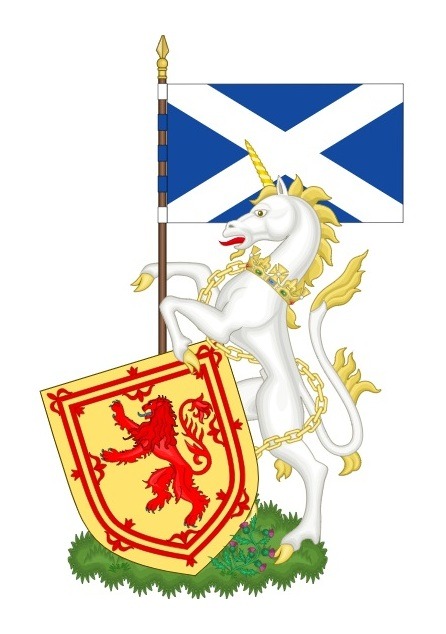




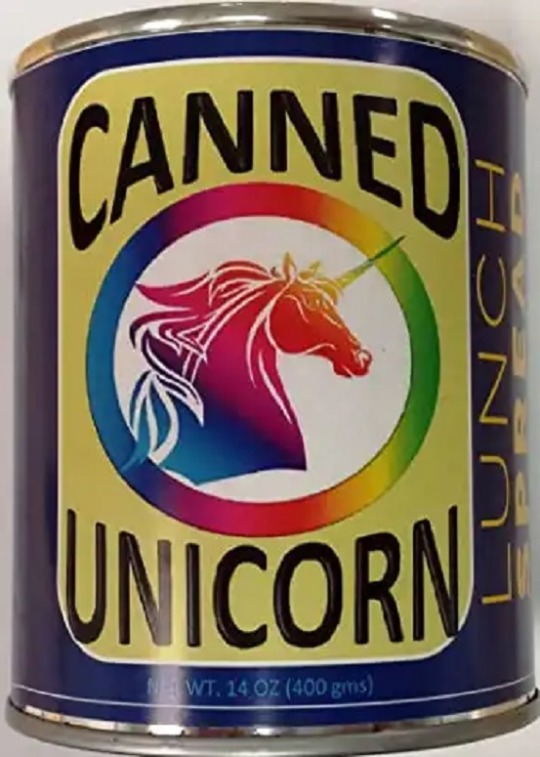
April 9th is National Unicorn Day.
Scotland is a treasure trove of proud history and trip-worthy adventure. Many people who are not familiar with the country’s antiquity may be surprised to find out that the national animal of Scotland is the unicorn. Though it may seem like an odd choice at face value, here are some reasons why choosing a unicorn was actually a bold and rebellious choice.
In Celtic mythology, unicorns symbolize unity, purity, courage, and strength. They are celebrated as healers, are thought to possess magical properties in their horns, and are considered one of the only animals powerful enough to defeat formidable opponents, such as elephants, in battle.
Legend claims only virgins could capture and tame a unicorn, and those who are lucky enough to touch one will know happiness and joy for the rest of their lives. Though in the stories, unicorns are powerful in their own right, some people believe the selection was made based on symbolism even older than the Celtic mythology.
Lore dating back to the ancient Babylonians said that unicorns were the natural enemy of lions - a symbol English royals had taken up centuries prior, so it's only natural Scots took up The Unicorn as s symbol!
Despite modern American depictions of unicorns as rainbow casting, cloud hopping pacifists, Scotland knows better. Still holding their centuries-old symbolism close to heart, the choice of the national animal makes much more sense once given some context.
Though Scotland’s royal coat of arms may have seen some changes, largely due to the Union with England, their identification with this mythical creature remains steadfast, with messages of virtue and strength holding strong centuries after its selection. I'm not sure about the tinned unicorn though!
86 notes
·
View notes
Text

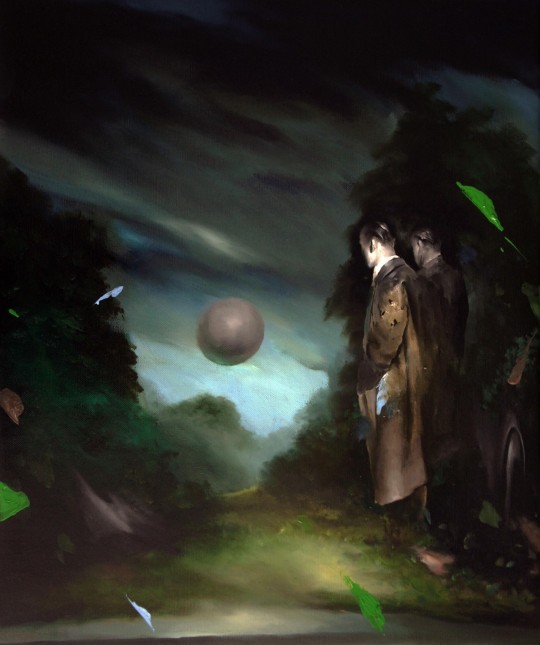
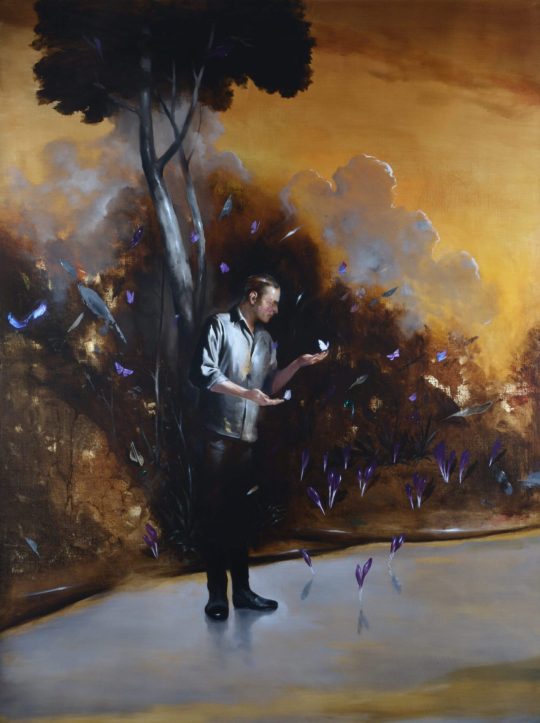
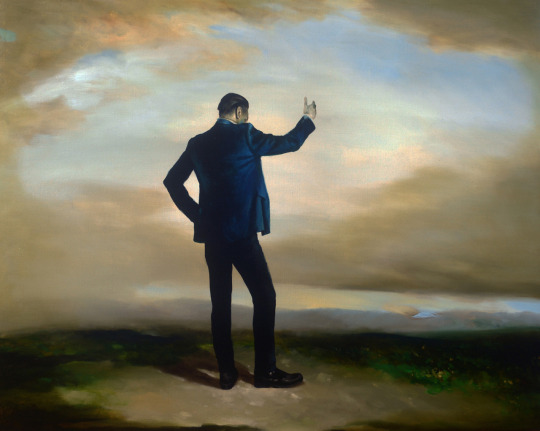
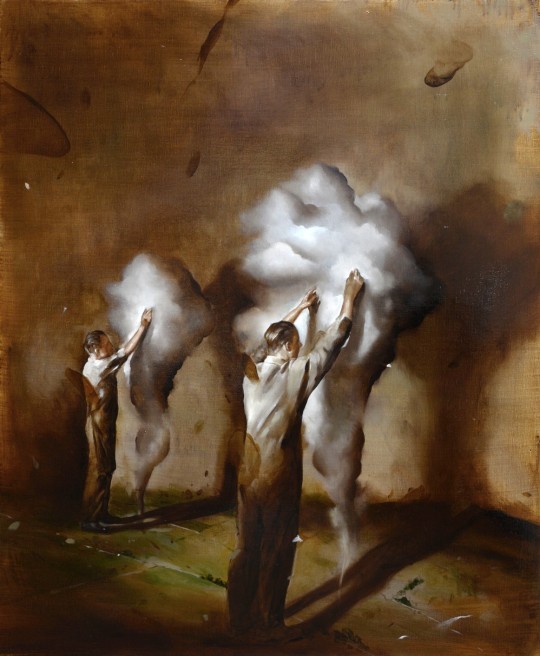

Radu Belcin, born 1978 Brasov, Romania, where he lives and works. He studied at the National University of Art in Bucharest.
“One could say Radu Belcin is a painter of the night; of twilight. He highlights the dwindling consciousness of our melancholic dispositions, which, in the persistently postive, glaringly lit storm of modern imagery, seems to illuminate the opposite: Darkness, nighttime, being alone in nature; and with it, figuratively, perhaps even symbolically: Regression and latency as reservoir of our oft romantically motivated memories. In an inimitable way, Radu Belcin’s compositions offer us a space—a stage—to reanimate the repressed, the desired, and the forgotten through an identification of his lonely archaically acting figures.” Excerpt written by Uwe Goldenstein
12 notes
·
View notes
Text
I want you to read these and keep them in mind.
The 14 Characteristics of Fascism
Powerful and Continuing Nationalism
Fascist regimes tend to make constant use of patriotic mottos, slogans, symbols, songs, and other paraphernalia. Flags are seen everywhere, as are flag symbols on clothing and in public displays.
Disdain for the Recognition of Human Rights
Because of fear of enemies and the need for security, the people in fascist regimes are persuaded that human rights can be ignored in certain cases because of "need." The people tend to look the other way or even approve of torture, summary executions, assassinations, long incarcerations of prisoners, etc.
Identification of Enemies/Scapegoats as a Unifying Cause
The people are rallied into a unifying patriotic frenzy over the need to eliminate a perceived common threat or foe: racial , ethnic or religious minorities; liberals; communists; socialists, terrorists, etc.
Supremacy of the Military
Even when there are widespread domestic problems, the military is given a disproportionate amount of government funding, and the domestic agenda is neglected. Soldiers and military service are glamorized.
Rampant Sexism
The governments of fascist nations tend to be almost exclusively male-dominated. Under fascist regimes, traditional gender roles are made more rigid. Opposition to abortion is high, as is homophobia and anti-gay legislation and national policy.
Controlled Mass Media
Sometimes to media is directly controlled by the government, but in other cases, the media is indirectly controlled by government regulation, or sympathetic media spokespeople and executives. Censorship, especially in war time, is very common.
Obsession with National Security
Fear is used as a motivational tool by the government over the masses.
Religion and Government are Intertwined
Governments in fascist nations tend to use the most common religion in the nation as a tool to manipulate public opinion. Religious rhetoric and terminology is common from government leaders, even when the major tenets of the religion are diametrically opposed to the government's policies
or actions.
Corporate Power is Protected
The industrial and business aristocracy of a fascist nation often are the ones who put the government leaders into power, creating a mutually beneficial business/government relationship and power elite.
Labor Power is Suppressed
Because the organizing power of labor is the only real threat to a fascist government, labor unions are either eliminated entirely, or are severely suppressed .
Disdain for Intellectuals and the Arts
Fascist nations tend to promote and tolerate open hostility to higher education, and academia. It is not uncommon for professors and other academics to be censored or even arrested. Free expression in the arts is openly attacked, and governments often refuse to fund the arts.
Obsession with Crime and Punishment
Under fascist regimes, the police are given almost limitless power to enforce laws. The people are often willing to overlook police abuses and even forego civil liberties in the name of patriotism. There is often a national police force with virtually unlimited power in fascist nations.
Rampant Cronyism and Corruption
Fascist regimes almost always are governed by groups of friends and associates who appoint each other to government positions and use governmental power and authority to protect their friends from accountability. It is not uncommon in fascist regimes for national resources and even treasures to be appropriated or even outright stolen by government leaders.
Fraudulent Elections
Sometimes elections in fascist nations are a complete sham. Other times elections are manipulated by smear campaigns against or even assassination of opposition candidates, use of legislation to control voting numbers or political district boundaries, and manipulation of the media.
Fascist nations also typically use their judiciaries to manipulate or control elections.
#my country is almost all of these#yours?#sorry not sorry for bringing that on your timeline#i just think it's important to know how fascism looks
17 notes
·
View notes
Text
Space Marines are not your friend
... and the Imperium of Man are not the good guys.

These guys, with the iron crosses and the scary face-masks, surprisingly not very nice.
So, there’s this idea that came up a bit in the discussions around space marines and gender that sometimes these guys can be heroic, and, um, actually it’s how they’re perceived as heroic that’s kind of the point, but we’ll come back to that.
Milton Bradley and Games workshop teamed up to release Space Crusade when I was 6 or 7 and I pestered my parents until they bought it for me for Christmas. Later, when I was 11 I was stuck at home with glandular fever and my family picked up some White Dwarf magazines from the local library for me to read and I realised there was more going on with this world, and I thought space marines were pretty cool. I used to imagine being a space marine. That’s because I didn’t understand what they represented. As I got older, and started to learn more about the symbols that GW were drawing on, that idea became less and less appealing.
In Warhammer 40,000, the Imperium of Man is a Fascist state. To be very clear, I don’t think it’s a bad game or fascist piece of media for depicting this. I think it was the intention of the game’s original creators to critically depict a futuristic dystopia, and the Fascist setting is part of that.
I think it’s clear that the Imperium engenders several of the 14 characteristics of Fascism identified by Lawrence Britt pretty unambiguously. The first is powerful and continuing Nationalism, Nationalism is based on the idea that a state should be congruent with a particular people, or volk, and outsiders should be excluded. Nationalism in the 41st Milennium is different to the Nationalism we’re used to because the volk in question is all of humanity, and the excluded parties are what the Imperium calls Xenos; Eldar, Orks, Tau, etc. Then there’s disdain for the recognition of human rights, human rights don’t really exist as a concept in 40K. You might ask the servitor or arco-flagellant about their human rights, or the 10 year-old child who’s taken from their home to begin the process of becoming a space marine. Identification of enemies/scapegoats as a unifying cause is a big one. The vilifcation of heretics, mutants and xenos is kind of a central tenet of the Imperium’s culture. There’s supremacy of the military, uh, I’m not sure I need to explain how the Imperium glorifies the Imperial Guard, the Astartes, all the chambers miltant, the knightly houses, the titan legions, the imperial navy, etc. etc. Rampant sexism, I hope my previous post has demonstrated this, but I think it’s important to note that sexism isn’t just disliking a particular gender, it’s expressed in the reinforcement of traditional and hegemonic gender roles, as I think the comparison of the Astartes’ and Sororitas’ roles demonstrates. There’s an obsession with national security, the Imperium’s entire economy is geared towards expansionism and dealing with internal and external threats. The intertwining of religion and government is pretty clear, the head of state is seen as a god and his church is the beaurecracy that runs the Imperial state. Supression of labour power is kind of assumed, there are no unions in the Imperium. The disdain for intellectuals and the arts is demonstrated by statements like “an open mind is like a fortress with its gates unbarred and unguarded” (That’s from Dawn of War). And there’s an obsession with crime and punishment, embodied by the existence of the Inquisition, in particular the Ordo Hereticus, who are a police force with unlimited power and the capacity to dragoon military units into their service.
These points often meet with the objection that the internal and external threats *do* exist and that therefor the Imperium’s response to them is justified, which kind of misses the point that this is a piece of fiction, an exploration of ideas. The existence of Xenos and the Chaos Gods doesn’t make the Imperium’s response to those things any less Fascistic, and they definitely don’t justify the existence of Fascism in the real world.
But, Warhammer 40,000 is an aesthetic game and Fascists looooove aesthetics, so I think an examination of how the Imperium draws on the aesthetics of Fascism is a bit more interesting.
Here’s a Susan Sontag quote I copied from the Wikipedia page on Fascism: “[f]ascist aesthetics ... flow from (and justify) a preoccupation with situations of control, submissive behavior, extravagant effort, and the endurance of pain; they endorse two seemingly opposite states, egomania and servitude. The relations of domination and enslavement take the form of a characteristic pageantry: the massing of groups of people; the turning of people into things; the multiplication or replication of things; and the grouping of people/things around an all-powerful, hypnotic leader-figure or force. The fascist dramaturgy centers on the orgiastic transactions between mighty forces and their puppets, uniformly garbed and shown in ever swelling numbers. Its choreography alternates between ceaseless motion and a congealed, static, 'virile' posing. Fascist art glorifies surrender, it exalts mindlessness, it glamorizes death."
I’m not going to provide a reference for that because this isn’t an essay and you’re not my lecturer and someone already did all the work (it’s in the wiki, linked above). I think I’m just going to take some extracts from that and juxtapose them with 40K art. Here goes:
a preoccupation with situations of ... extravagant effort
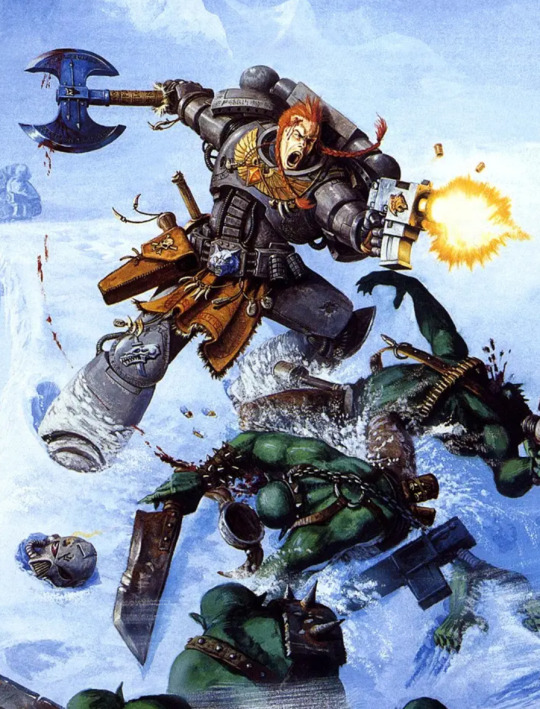
and the endurance of pain

they endorse two seemingly opposite states, egomania and servitude

a characteristic pageantry: the massing of groups of people
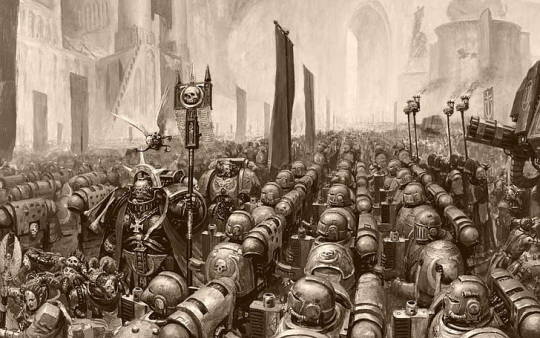
the turning of people into things
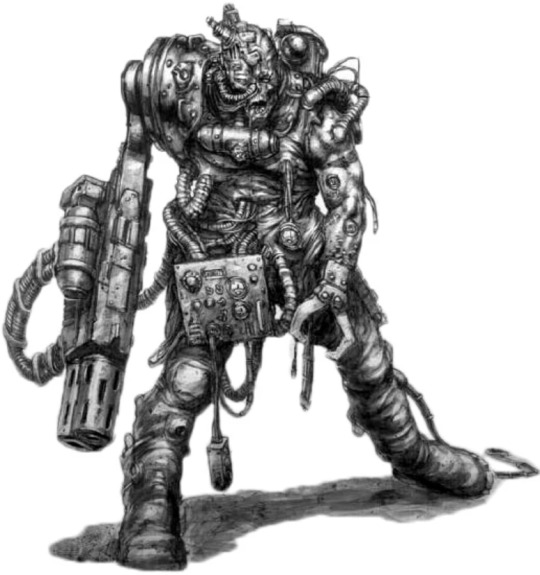
an all-powerful, hypnotic leader-figure or force
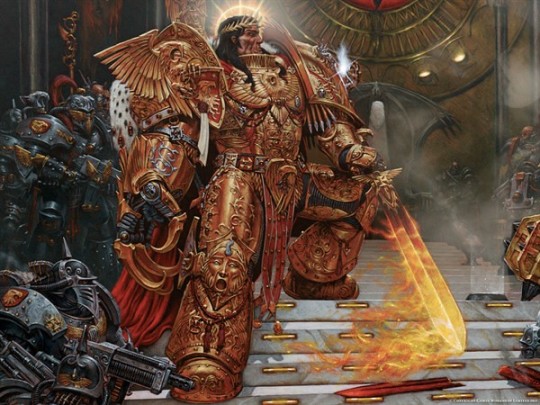
The fascist dramaturgy centers on the orgiastic transactions between mighty forces and their puppets, uniformly garbed and shown in ever swelling numbers
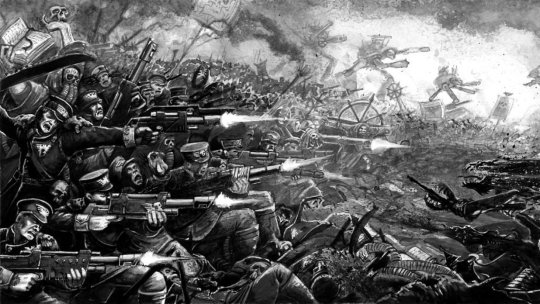
a congealed, static, 'virile' posing
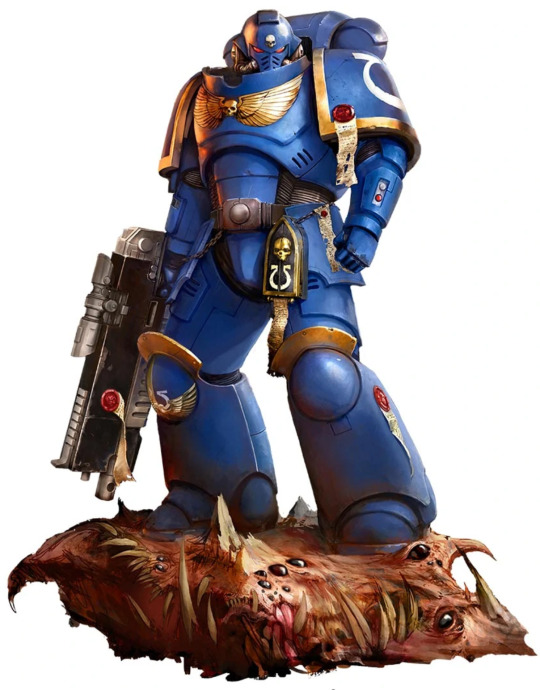
it glamorizes death

(I thought about adding a little speech bubble saying “even in death I still serve” but I think most people reading this recognise that that’s a walking, fighting coffin, I don’t think there’s a more explicit depiction of the glamourisation of death than the idea of a warrior so commited to war they they allow their corpse to be interred in a fighting machine so they can continue to kill after they’ve died.)
I’m particularly interested in how space marines fill the role of the ‘hero’. Nazis loved art that showed idealised male figures, preferably from pagan myths. Here’s a sculpture of Prometheus that was exhibited at their “Great German Art Exhibition”:

They loved heroic figures, muscular and mythic men of action. They saw in Nietszche’s ubermensch an individual who had the strength and will to do what he wanted, and take what he wanted, without concern for the morality of the ‘sheep’. It goes without saying that these figures were meant to be of Aryan descent and in the Nazi state the SS were meant to be the modern expression of this. Recruits to the SS had to ‘prove’ their Aryan ancestry and Himmler had plans to institute requirements for appearance and height. I think it’s clear how they were meant to be a fighting force who’s superiority came from their supposed genetic superiority and connection to an idealised Aryan heroism.
And that’s where space marines come in. Astartes are the way they are because of their connection, through gene-seed, to the primarchs (The Emperor’s largest sons), heroic and promethean figures from the dawn of the Imperium who made war on a grand scale and spread the Emperor’s light to the far reaches of the galaxy. Their genetics make them into literal superhumans, able to perform heroic feats that would be impossible for a regular person. This isn’t a good thing, it’s an expression of Fascist ideology. Warhammer 40K, being satire, recognises this, and so it’s constantly made clear that these people are incapable of anything but war. Also the marinification process makes them so muscular they resemble sides of beef more than actual people, they’ve become a grotesque mockery of the ideal of the Hero.
Also there are skulls and eagles on, like, everything, and that’s normally a sign that Fascists are about. There’s also a particular fascination Fascists have with the imagery of the Roman Empire, the word Fascism comes from fasces, a bunch of rods bound together with an axe that was the symbol of Roman dicators. Ultramarines in particular use a lot of Roman inspired armour elements.
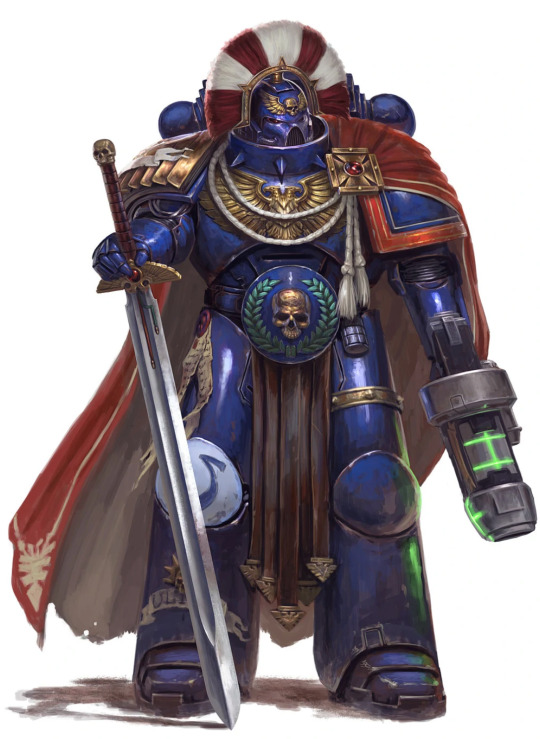
The headpiece, wreath at the midriff, and leather straps hanging between the legs are all screaming Rome at me, and I don’t think these guys are history buffs (They’re Fascists).
Anyway, there we go, I think I’ve established that the original 40K writers intended for the Imperium to be a Fascist state. I’m enjoying this, maybe next I’ll write something about the Eldar and Slaanesh and ideas aboout degeneracy that were floating around at the turn of the 19th Century.
UPDATE: I've developed my thoughts on this further here.
171 notes
·
View notes
Text
ISRAEL REALTIME — war news - mid day
— NY MAYOR… New York City will send medical aid to Israel as a measure of solidarity and support.
— THE TOLL… 798 civilians were murdered in the war and have been identified, which is about 84% of the martyrs who were murdered in the invasion and whose bodies have been brought for identification. 697 martyrs have been brought to burial so far.
— THE BUDGET… The budget of the Jewish National Identity Authority of MK Avi Maoz will be transferred to help the evacuees. MK Avi Maoz is the third in the coalition whose ministry funds that were intended for his missions are transferred to benefit the needs of the war.
— POLITICS… Israeli Arab parties Ra’am and United Arab List voted against a bill to combat the consumption of terrorist content (via social media) in Israel. The police have been particularly active in arresting those publishing such content or support content for Hamas within Israel during the war.
— THE ZIKIM ATTACK… IDF announces 2 terrorists killed last night. Previous unofficial reports ranges from 4 to 11.
— DRUZE VS ISRAEL ARABS… A huge fight broke out in a school in Ma’ar in the north. A group of Israeli Arabs were protesting for Hamas, the Druze students took exception and a large fight broke out. 13 arrested, 4 injured.
— AN AIRLINE RETURNS… Ethiopian Airlines (Ethiopian Airlines) returns to fly to Israel starting this Thursday, October 27. The first flight from Tel Aviv will depart on October 28, at 02:20.
— IDF PUBLISHES TERRORIST MOTIVATION AND INSTRUCTION NOTE (gruesome warning) … a handwritten note was found on a terrorist body. It is an order to kill Jews, words of encouragement, encouragement to carry out a merciless massacre while receiving inspiration from leaders in Muslim history who became a symbol of jihad. The terrorists are encouraged to decapitate, remove hearts and livers, and repeat the massacres of historical Muslim leaders who massacred men, sold women and children into slavery and looted cities.
IDF Link
— ISRAEL FIREARMS LICENSE LINK IN ENGLISH
21 notes
·
View notes
Text



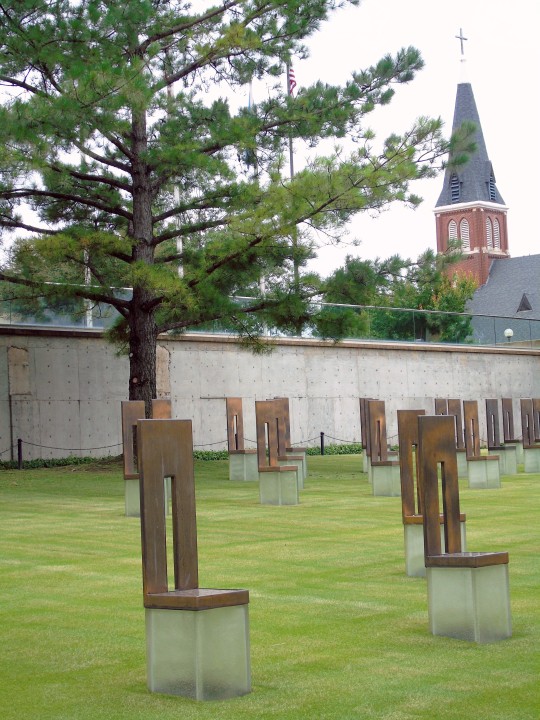
















National Oklahoma City Bombing Commemoration Day
National Oklahoma City Bombing Commemoration Day is celebrated on April 19 annually. This day aims at honoring the deceased, injured, and volunteers when the devastating event occurred. Two anti-government extremists — Timothy McVeigh and Terry Nichols perpetrated the terrorist attack. They did this with white supremacists and right-wing terrorist sympathies. The bombing happened at 9:02 a.m. at the Alfred P. Murrah Federal Building in Oklahoma City, Oklahoma, and killed at least 168 people, injured more than 680 others, and destroyed more than one-third of the building.
History of National Oklahoma City Bombing Commemoration Day
Timothy McVeigh, an ex-Army soldier and security guard, parked a rented Ryder truck in front of the Alfred P. Murrah Federal Building in downtown Oklahoma City on April 19, 1995. He decided to commit mass murder there. The bomb was a powerful one. It consisted of a deadly cocktail of agricultural fertilizer, diesel fuel, and other chemicals. McVeigh got out of the rented car with the bomb inside, locked the door, and headed towards his getaway car. He ignited one timed fuse, then another. At 9:02 a.m., the bomb exploded.
A third of the building had been reduced to rubble in just a few seconds, with many floors flattened. The surrounding area looked devastated. More than 300 nearby buildings were damaged or destroyed; dozens of cars were incinerated. The consequences to human beings were still more devastating: 168 souls were lost, including 19 children, with several hundred more injured.
It was the worst act of terrorism in United States history. The F.B.I. quickly arrived at the scene to support rescue efforts and investigate the facts. There were clues in the area they found. On April 20, thanks to the rear axle of the Ryder truck, the vehicle identification number was traced to a body shop in Junction City, Kansas. Employees helped the F.B.I. quickly compose a composite drawing of the man who had rented the van. F.B.I. agents started to show the sketch around town, and local hotel employees supplied a name: Tim McVeigh.
National Oklahoma City Bombing Commemoration Day timeline
1995The Bombing Occurs
On April 19, 1995, the Alfred P. Murrah Federal Building in downtown Oklahoma City is destroyed by a terrorist attack.
1997Terrorists are Tried
The bombers are tried and convicted.
2001McVeigh is Executed
McVeigh is sentenced to death, and executed by lethal injection.
2003Alfred P. Murrah Federal Building is Replaced
The Alfred P. Murrah Federal Building is replaced with a 185,000-square-foot building.
National Oklahoma City Bombing Commemoration Day FAQs
What components' symbols are used in the Oklahoma City Memorial?
There are nine rows, each representing a floor of the federal building where the field is now located. Each chair has the name of someone killed, and smaller chairs stand for the children.
How old was Timothy McVeigh when he was executed?
He was 33 years old.
Why is it difficult for the United Nations to draft a definition of terrorism?
Mainly because the characteristics of terrorism are hard to define. Many member countries harbor terrorists.
How to Observe National Oklahoma City Bombing Commemoration Day
168 seconds of silence
Information
Post on social media
168 people died in the bombings. The nation joins 168 seconds of silence to honor those people.
Learn about terrorist attacks and bombings. Learn how Oklahoma City recovered from this devastating event.
Write a post on social media to raise awareness about this commemoration day. Do not forget to use the hashtag #OklahomaCityBombingCommemorationDay.
5 Terrorist Attacks In History
AMIA bombing
U.S. Embassy Bombings
September 11 attacks
Christmas massacres
7/7 bombings
It occurred in 1994 in Buenos Aires, Argentina.
It occurred in 1998 in Kenya and Tanzania.
It occurred in 2001 in New York, United States.
It occurred in 2008 in the Democratic Republic of Congo.
These occurred in London, killing 56.
Why National Oklahoma City Bombing Commemoration Day is Important
It is a day to remember
It is a day to raise awareness
It is an opportunity to address threats of violence
This day is perfect for remembering those who died not only in the Oklahoma Bombing but also in any other terrorist attacks. Many people die in this type of attack.
This day is also helpful in raising awareness about the problem of terrorism. Security issues affect almost all countries.
Awareness is crucial to disrupting terrorist plots to avoid future attacks. Governments should be committed to holding accountable those who perpetrate such attacks.
Source
#National Oklahoma City Bombing Commemoration Day#19 April 1995#USA#Oklahoma City#Oklahoma#anniversary#US history#white terrorism#travel#summer 2014#South Central Region#original photography#tourist attraction#landmark#reflecting pool#cityscape#Oklahoma City National Memorial#OklahomaCityBombingCommemorationDay#Field of Empty Chairs#Survivor Tree#Gate of Time#Survivors' Wall#architecture#vacation
6 notes
·
View notes
Photo

François Clouet (FR, 1510 - 1572)
Dame au bain (A Lady in Her Bath), ca. 1571 [detail]. Oil on oak wood 92.3 × 81.2 cm (36.3 × 31.9 in) Collection National Gallery of Art, Washington, D.C.
The allegorical analysis of many details (ironic presence of the unicorn; bowl of fruit, symbol of sensual gluttony with the bunch of grapes, red carnation symbol of her multiple engagements) suggests that the bare-breasted woman is Mary Stuart whose sentimental deviations were the laughingstock of all Europe.)
The painting could also be an allegory of the three theological virtues: the child would be hope, the nurse would be nourishing faith and the naked woman would be charity.
The National Gallery writes:
The masklike symmetry of the bather's face makes exact identification difficult; scholars have suggested that her aristocratic features indicate that she is one of several royal mistresses of Henry II, most notable among them Diane de Poitiers. It is possible that the nude, a Venus type, represents ideal beauty rather than a specific individual. The contrast of the smoothly rendered nude figure to the intricate surface details of the fruit, draperies, and jewelry, presents a union of Flemish and Italian motifs that characterized French courtly art of the sixteenth century.
https://en.wikipedia.org/wiki/A_Lady_in_Her_Bath
36 notes
·
View notes
Text
"...at a revolution two paths are possible. So indeed they are in evolution – one can either stay still and be classical, academic and null, or go forward. But at a time of revolution it is not possible to stay still, one must either go forward, or back. To us this choice appears as a choice between Communism and Fascism, either to create the future or to go back to old primitive values, to mythology, racialism, nationalism, hero-worship, and participation mystique. This Fascist art is like the regression of the neurotic to a previous level of adaptation.
It is D. H. Lawrence’s importance as an artist that he was well aware of the fact that the pure artist cannot exist to-day, and that the artist must inevitably be a man hating cash relationships and the market, and profoundly interested in the relations between persons. Moreover, he must be a man not merely profoundly interested in the relations between persons as they are, but interested in changing them, dissatisfied with them as they are, and wanting newer and fuller values in personal relationships.
But it is Lawrence’s final tragedy that his solution was ultimately Fascist and not Communist. It was regressive. Lawrence wanted us to return to the past, to the ‘Mother’. He sees human discontent as the yearning of the solar plexus for the umbilical connexion, and he demands the substitution for sharp sexual love of the unconscious fleshy identification of foetus with mother. All this was symbolic of regression, of neurosis, of the return to the primitive.
Lawrence felt that the Europe of to-day was moribund; and he turned therefore to other forms of existence, in Mexico, Etruria and Sicily, where he found or thought he found systems of social relations in which life flowed more easily and more meaningfully. The life of Bourgeois Europe seemed to him permeated with possessiveness and rationalising, so that it had got out of gear with the simple needs of the Body. In a thousand forms he repeats this indictment of a civilisation which consciously and just because it is conscious – sins against the instinctive currents which are man’s primal source of energy. It is a mistake to suppose that Lawrence preaches the gospel of sex. Bourgeois Europe has had its bellyful of sex, and a sex cult would not now attract the interest and emotional support which Lawrence’s teaching received. Lawrence’s gospel was purely sociological. Even sex was too conscious for him..."
- Christopher Caudwell, "D. H. Lawrence: A Study of the Bourgeois Artist,” in Studies in a Dying Culture. First published posthumously by Bodley Head in 1938.
#christopher caudwell#communist party of great britain#d. h. lawrence#literary criticism#marxism#marxist criticism#literary quote#bourgeois culture#bourgeois society#anti-intellectualism#capitalism#fascism
4 notes
·
View notes
Text
In early December, a rightwing Wisconsin organization called HOT Government sent out a breathless email: Mike Lindell, the pillow salesman turned election conspiracy theorist and staunch Donald Trump ally, had nominated an important Wisconsin politician for a dubious award.
The prize would go to the person who exemplifies “leadership in BEING AN OBSTACLE TO STOPPING ELECTION CRIME”, the email declared.
Lindell’s target wasn’t a Democrat, nonpartisan election official or even a moderate Republican – it was Robin Vos, the powerful Wisconsin Republican assembly speaker.
The nomination reflects a stark turn of fortunes for Vos, who has spent more than a decade using every tool at his disposal to cement Republican power in Wisconsin, touting a deeply conservative record including on voting.
Vos helped re-draw the state’s legislative maps in 2011, ensuring Republican control of the legislature ever since. The same year, he followed former Republican governor Scott Walker’s lead in creating the most restrictive voter identification law in the country and passing legislation to kneecap union power in a state where organized labor was once the core of the Democratic coalition.
Vos was elected speaker of the assembly in 2013 and has used his years in office since to shore up his party’s minoritarian lock on power in the swing state. When Republicans lost the governorship in 2018, the assembly quickly passed legislation that curbed the power of the incoming Democratic governor. And after Trump lost the state in 2020, Vos initiated an investigation into Wisconsin’s election, hiring a promoter of the “Stop the Steal” movement to lead it.
He was in all respects a loyal rightwinger. But Vos has drawn a line at embracing Trump’s false claim that he actually won Wisconsin in 2020 and refused to join colleagues who suggested overturning the 2020 election. His unwillingness to cross that line has turned him into a pariah on the far right, a target of Lindell, an enemy of Trump and a symbol of the current state of the Republican party where loyalty to Trump is the key litmus test.
Now, Vos is fighting elements of his party that rejected the results of the 2020 election and have come to view him not as a hardline conservative who has done more than almost anyone else to strengthen Republicans’ power in the state, but as a corrupt establishment hack complicit in Trump’s undoing.
With the Trump flank of the grassroots Wisconsin Republican party as strong as ever ahead of the 2024 election, Vos is scrambling to appease his hardline party detractors so he doesn’t become a casualty of the movement he helped create.
“There’s a segment of the Maga crowd who despises him, because they adamantly believe President Trump was cheated,” said a veteran Wisconsin GOP operative, who spoke anonymously given his role within pro-Trump circles. “Where he is right now is kind of emblematic of the fight going on within the Republican party – here in Wisconsin and across the nation.”
From the young Republican …
Since he was a child, Vos led a political life. In sixth grade, he tagged along with a teacher to political events, then joined the Young Republicans and worked for former Republican governor Tommy Thompson before starting college. During his first semester at the University of Wisconsin-Whitewater, Vos ran for and won a seat on the student senate and then went about lobbying every member of the Wisconsin state legislature for reduced tuition hikes.
His eagerness was rewarded two years later, when Governor Thompson appointed Vos to be a student member of the University of Wisconsin system’s governing body. Vos surrounded himself with other young Republicans: his roommate and friend at UW-Whitewater, Reince Priebus, would go on to chair the Republican National Committee for six years before working as Donald Trump’s chief of staff in 2017.
After graduating in 1991, Vos snagged a job as a legislative aide to Bonnie Ladwig, a leader in the Wisconsin state assembly, then returned home to Burlington, in south-east Wisconsin, and won a seat on the Racine county board. When Ladwig retired a decade later in 2004, Vos won her seat.
“Jim and Bonnie Ladwig were super close to me,” Vos told the Guardian, sitting at the end of a long and formidable wooden table in his Capitol office. Vos had been taking back-to-back interviews all day but he was focused and energized. “They were like a second set of parents – and then Tommy Thompson, I talk to him almost every week – Governor Evers, annually.”
Vos advanced quickly in the assembly, learning how to manage the personalities in the Republican caucus and when to make bipartisan alliances. Perhaps emulating his slogan as a college politician – “We want your views” – Vos earned the reputation of listening carefully to his colleagues and learning their vulnerabilities and strengths.
“I really want to be a consensus builder,” said Vos, who said he believed eking out a policy win, even a small one, was worthwhile – and faulted the contemporary Republican party for adopting what he viewed as an all-or-nothing politics.
Mark Pocan, a progressive Democratic congressman in the state, who sat on the joint committee on finance with Vos, formed an unlikely friendship with the legislator. “I always found him someone that I can have [a] conversation with,” said Pocan. “He’s very effective in knowing how to work his members to get things done.”
“Everybody seems to think that Robin tells everybody in the caucus, ‘You will vote this way, you will do this, you will do that,’ and it’s not that way at all,” said Kathy Bernier, a Republican who served in the assembly for five years under Vos’s leadership. “He will be always cognizant of the vulnerable members of his caucus.”
But Vos has also gained a reputation for cracking down on uncooperative members of his caucus and withholding committee seats from disloyal members. In 2016, he withheld committee appointments from three conservative lawmakers who had previously clashed with him. Most recently, his caucus removed Janel Brandtjen, an election denier and Republican staterepresentative, from her leading role on the elections committee after she endorsed his primary opponent.
None of the seven leaders of the Republican caucus in the assembly agreed to an interview.
… To ‘the prince of darkness’
Under Vos’s leadership, the Republican-controlled legislature has flexed outsized power in Wisconsin. While statewide races are often determined by vanishingly narrow margins, Republicans can comfortably count on strong majorities in the legislature – a product of the 2011 redistricting law Vos helped craft. He currently presides over a 64-35 seat majority in the assembly, which he has leveraged to strengthen Republican power in the state.
But Vos is quick to contest the view, held by many Democrats, that his legislative style is anti-democratic – or really anything but good, effective politics. “Democrats can’t accept that because they think the only reason they’re losing is the maps – maybe it’s your strategy. Maybe it’s your campaign, maybe it’s the issues you run on.”
Also in 2011, Vos helped push through one of the most restrictive voter identification laws in the nation; independent studies have found it disproportionately impacts low-income and Black voters, but the law has nonetheless survived numerous court challenges by voting rights advocates. When Wisconsin’s government accountability board found in 2015 that the legislature had failed to provide sufficient education around the new voter ID rules, a requirement of their own law, the assembly voted to dissolve the board.
After Democrats won races for governor and attorney general in the 2018 election, Vos rushed through laws limiting the powers of both offices in the weeks before they took office. The “lame duck” legislation, among other provisions, limited the governor’s authority to appoint leaders to certain state agencies and gave the legislature the right to hire outside lawyers to intervene in lawsuits. The power grab outraged Democrats and good-government groups and illustrated the lengths to which Republicans in office would go to wrest power from their opponents. A 2022 Politico article referred to Vos as the state’s “shadow governor”.
In 2015, Vos even tried to bring about a law that would shield state lawmakers entirely from public records requests. The effort failed, but he and other members of his caucus are known to habitually delete their work emails – a practice that, while legal, makes it harder for journalists and the public to access documents.
“When it comes to sunshine in government, Robin Vos is the prince of darkness,” said Bill Lueders, a political journalist and the president of the Wisconsin Freedom of Information Council.
He has developed a reputation for obstinance towards working with Democrats in office. In early 2020, while Republican- and Democratic- led states across the country delayed primary elections amid the rapidly-spreading coronavirus, the state legislature shut down attempts by Tony Evers, the Democratic governor, to move the date of the Wisconsin primary. In a viral image, Vos, donned in head-to-toe protective gear and volunteering as a poll worker, told voters it was “incredibly safe to go out”.
A ‘rigged and stolen election’
After years of fighting Democrats, the 2020 election brought Vos into a separate and unexpectedly fierce conflict – with his own party.
A day before the scheduled certification of the presidential election in Congress, as Trump supporters piled into buses headed for Washington, DC for a rally that would devolve into the January 6 Capitol riot, 14 Wisconsin lawmakers – including 13 members of the assembly – signed a letter addressed to Mike Pence, the vice-president, urging him not to certify the election. The missive, signed by lawmakers in five swing states, accused governors and state officials of “obfuscation and intentional deception” and claimed state legislatures have the final say in certifying the election results. The chair and vice-chair of the Wisconsin assembly committee on campaigns and elections were among the signatories.
Vos did not sign. But in a press conference that day, he told reporters he took the party’s rightwing base seriously and said the widespread doubt about the election results called for a re-evaluation of the electoral process. Since then, he’s sought to walk a tightrope of appeasing his base while refusing to bow to their wildest demands. But that has proven challenging.
Trump and his allies spent months filing lawsuits to try to overturn his loss in Wisconsin and other states. When his lawsuit asking the Wisconsin supreme court to toss out thousands of votes cast in Democratic strongholds failed, he tried to pressure Vos and other Republicans in the legislature to decertify the election themselves.
“I think it is unlikely we would find enough cases of fraud to overturn the election,” Vos told reporters at the time, suggesting that the state first investigate the 2020 election.
The Republicans’ refusal to actually attempt to decertify the election angered Trump. In June 2021, as Wisconsin Republicans gathered for their annual convention, Trump issued a statement accusing Vos and other legislative party leaders of “working hard to cover up election corruption”.
Vos has responded to Trump’s attacks by alternatively rejecting his wild claims while at the same time granting political concessions to groups peddling conspiracy theories.
Under pressure from Trump, Vos in 2021 announced an investigation into the election, appointing Michael Gableman, a former Wisconsin supreme court justice who had bolstered Trump’s disproven claims of election fraud and spoken at a Wisconsin “Stop the Steal” rally shortly after the 2020 election, as special counsel. During his investigation, Gableman traveled across the US, speaking at an elections conference hosted by Lindell and viewing the discredited Cyber Ninjas election audit in Maricopa county, Arizona.
A year later, when the Wisconsin supreme court ruled that the use of ballot “dropboxes” during the 2020 election was unlawful, the former president approached Vos with another call to decertify the election. “I explained that it’s not allowed under the constitution,” Vos told WISN-TV 12 News in Milwaukee.
Trump was furious. Days later, the former president endorsed Adam Steen, Vos’s election-denying primary opponent, calling Steen a “rising patriotic candidate” and denouncing Vos.
Vos barely survived the primary, winning by less than 300 votes.
“One of my biggest regrets was hiring Gableman,” said Vos, who fired the judge days after his primary. “He was way wackier than I thought. He was disappointing. He was inept. He was way worse for the system.”
As Trump turned on Vos, cracks within the Wisconsin GOP deepened.
Vos was roundly booed at the state convention in 2022 for telling the delegates that lawmakers “have no ability to decertify the [2020] election and go back and nullify it” .That day, more than a third of the delegates voted to oust him from party leadership.
Vos will not break the law to try to win them over, but he’s still looking to win back some of their support – all while trying to keep himself and the Republican party in power amid a shakeup in the Wisconsin supreme court.
After voters elected liberal justice Janet Protasiewicz to the state’s highest court, Vos entertained the idea of impeaching her before she could rule on the constitutionality of the state’s gerrymandered maps, only dropping the cause when a panel of former justices recommended against it.
Vos has also come under pressure from election denying groups to oust Meagan Wolfe, Wisconsin’s nonpartisan election commissioner who became a target of false claims that she broke the law to hurt Trump in 2020.
“As the leader, [Vos] takes the brunt of it,” said the state senator Duey Stroebel, a Republican who served in the assembly for four years and has, like Vos, worked on restrictive voting laws during his tenure. “He’s kind of the poster boy for these things.”
Vos has echoed calls for Wolfe to step down. But he has slow-walked impeachment efforts, referring impeachment articles to an assembly committee in November, where they have languished since. A group that goes by the name “Wisconsin Elections Committee, Inc” has spent hundreds of thousands of dollars on TV and newspaper ads running regularly since November pressuring Vos to impeach Wolfe.
“It’s not gonna happen,” Vos said brusquely, voicing his irritation at Trump and his allies’ unyielding focus on the 2020 election. “Donald Trump’s unhealthy obsession with 2020 is not what Americans want to hear about in 2024.”
But at this point, it seems unlikely Vos can do much more to satisfy the far right base of his party. Even if he pivots and sees Wolfe’s impeachment through, a move that could destabilize elections ahead of 2024, the right wing will likely continue to ramp up their anti-democratic demands.
“As long as Donald Trump is politically active, they will be politically active,” said Bernier, who has been vocal in pushing back against Trump’s election lies – and counts Vos as a friend. Wisconsin activists who challenge election outcomes, she said, “will continue this until Donald Trump is no more”.
3 notes
·
View notes
Text
A Thing Of Vikings Chapter 148: Assumptions Of Power

Chapter 148: Assumptions Of Power
It should be noted that the process of forming a national identity is a significant one in itself. Citizenship is only part of the answer, as most people will still identify with their immediate regional, ethnic, or religious group, allowing for social fault lines to form. Generally speaking, a central “pole” is needed to act as a unifying force of identification in any large-scale nation-state. This can be a national epic, a written constitution, a venerated royal dynasty, an ideology, a larger ethnicity, or a religious institution, but to help weld together more multitudinous groups, some unifying symbol of identification is needed to be able to create the social institutions that allow for members of the nation to identify as members of the nation, as opposed to seeing themselves as part of the nation only through their identity as members of a social group which is a constituent part of that nation.
This might seem like splitting semantics, but it is an important distinction. If a feudal count declares war on his neighboring count in the hope of taking some of the man’s territory, despite them being part of the same kingdom, which perspective is more useful for halting hostilities? That their levies owe them fealty and thus must follow their orders? Or that their levies are being ordered to attack and kill their fellow subjects of the kingdom? The latter is clearly the more effective means by which to bond the two disparate groups together under a single unifying identity, even though there is no structural legal difference between the two.
Of course, there is always the option of coercive power by a central government to forcibly keep the peace between disparate groups, but this is rarely a long-term solution…
—Nationbuilding: How People Move, Talk, Think, Organize, & Structure Themselves, 1888, Amsterdam University Press
AO3 Link
20 notes
·
View notes